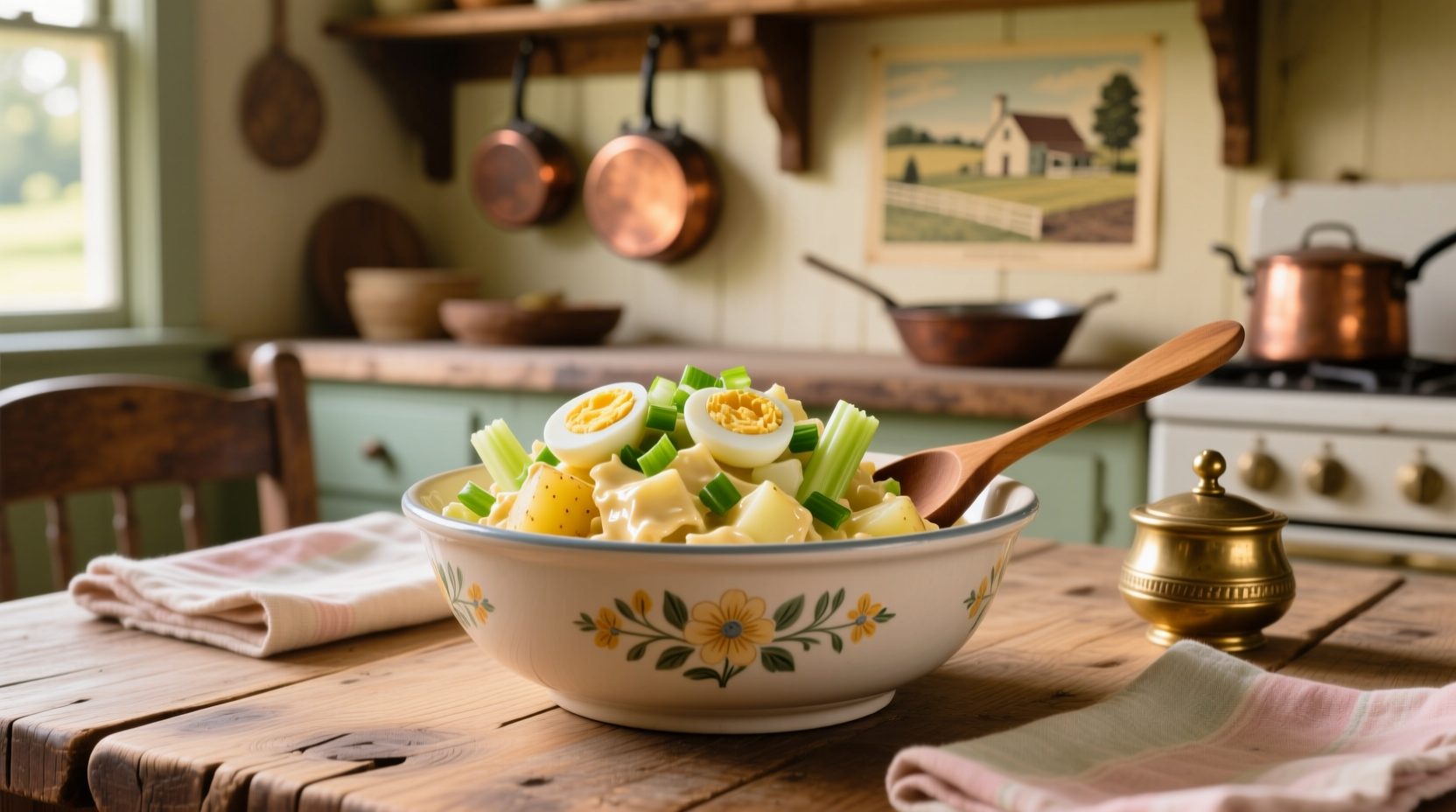There's something deeply satisfying about a perfectly executed old fashioned potato salad. Unlike modern variations loaded with extras, the traditional version celebrates simplicity and balance. As a culinary historian who's traced this dish's journey from European tables to American picnic baskets, I've discovered that understanding its roots is key to perfecting it.
What Makes Potato Salad "Old Fashioned"?
The term "old fashioned" in potato salad refers to preparations dating from the late 19th to mid-20th century, before convenience ingredients became commonplace. These recipes emphasize:
- Waxy potatoes like Yukon Gold or red potatoes that hold their shape
- Homemade or simple commercial mayonnaise without added sugars
- Vinegar-based dressing for brightness
- Minimal ingredients that showcase quality components
- No bacon, pickles, or sweet relish that characterize modern versions

Historical Evolution of Potato Salad
Potato salad's journey reveals why certain preparations qualify as "old fashioned." Originally a German dish called Kartoffelsalat, it crossed the Atlantic with European immigrants. The American version evolved significantly through three distinct phases:
| Time Period | Key Characteristics | Historical Context |
|---|---|---|
| 1880-1920 | Vinegar-based dressings, minimal ingredients, German preparation methods | Immigrant communities maintained European traditions; potatoes were often boiled with skins on |
| 1920-1950 | Introduction of mayonnaise-based dressings, addition of hard-boiled eggs, celery, and onions | Rise of commercial mayonnaise; cookbooks like Fannie Farmer's Boston Cooking-School Cook Book standardized recipes |
| 1950-Present | Regional variations emerge, addition of bacon, pickles, sweet relish, and other modern ingredients | Post-war prosperity led to ingredient experimentation; regional cookbooks documented local preferences |
Essential Ingredients for Authentic Preparation
When preparing old fashioned potato salad, ingredient selection determines authenticity. The USDA Agricultural Research Service confirms that waxy potato varieties maintain structural integrity better during preparation, which is essential for traditional texture.
Potato Selection Guide
Choose varieties with higher moisture and lower starch content:
- Yukon Gold - The ideal compromise with buttery flavor and firm texture
- Red Bliss - Traditional choice that holds shape well
- Fingerling - Historic variety used in early American preparations
Avoid russet potatoes, which become too fluffy and absorb dressing unevenly. According to the University of Illinois Extension, boiling potatoes with skins on preserves texture and prevents waterlogging—a technique documented in 1930s-era community cookbooks.
Traditional Preparation Techniques
The method matters as much as the ingredients when creating authentic old fashioned potato salad. Follow these time-tested steps for best results:
Perfect Potato Cooking Method
- Start with cold, salted water (1 tablespoon per quart)
- Add potatoes with skins on
- Bring to gentle simmer (not rolling boil)
- Cook until just tender (15-20 minutes depending on size)
- Drain and cool slightly before peeling
This technique prevents the potatoes from absorbing too much water, which would dilute the dressing. The National Center for Home Food Preservation recommends this method for maintaining proper texture in potato salads.
Dressing Preparation Secrets
The dressing makes or breaks traditional potato salad. Authentic old fashioned versions use:
- 1 cup mayonnaise (preferably full-fat)
- 2 tablespoons yellow mustard
- 1 tablespoon white vinegar
- 1 teaspoon salt
- ½ teaspoon black pepper
- 1 diced celery stalk
- 2 chopped hard-boiled eggs
- ¼ cup finely diced onion
Mix dressing ingredients first, then gently fold into warm (not hot) potatoes. This allows the potatoes to absorb flavors without becoming mushy. The American Egg Board confirms that adding dressing to slightly warm potatoes creates optimal flavor integration.
When to Stick with Tradition (and When to Adapt)
Understanding context boundaries helps determine when to follow traditional preparation methods:
- Stick with tradition for family gatherings, historical reenactments, or when showcasing culinary heritage
- Consider adaptations for dietary restrictions (like using vegan mayo) or when catering to diverse palates at large events
- Maintain core elements (simple dressing, waxy potatoes, minimal ingredients) even when making small adjustments
Food historians at the Smithsonian Institution note that the most successful traditional preparations honor the dish's historical context while acknowledging modern food safety practices.
Serving and Storage Guidelines
For authentic presentation and food safety:
- Chill for at least 4 hours before serving (overnight is ideal)
- Use vintage-style serving dishes like glass bowls or enamelware
- Store in refrigerator for up to 3 days
- Never leave at room temperature for more than 2 hours
The FDA Food Code specifies that egg-containing salads like potato salad should be kept below 40°F (4°C) to prevent bacterial growth. Traditional preparations with vinegar-based dressings have slightly longer safe storage times due to the acidic environment.
Common Mistakes to Avoid
Even experienced cooks make these errors with old fashioned potato salad:
- Overcooking potatoes - Results in mushy texture that absorbs too much dressing
- Adding dressing to hot potatoes - Causes mayonnaise to break and potatoes to become waterlogged
- Using the wrong potato variety - Russets create an undesirable fluffy texture
- Overmixing - Breaks potato pieces and creates a homogenous mush
- Skipping the resting period - Prevents flavors from properly melding
Final Thoughts on Authentic Preparation
Mastering old fashioned potato salad requires understanding both technique and tradition. By focusing on quality ingredients, proper potato selection, and time-honored preparation methods, you'll create a dish that connects modern diners with culinary history. The simplicity of authentic old fashioned potato salad isn't a limitation—it's the key to its enduring appeal across generations.











 浙公网安备
33010002000092号
浙公网安备
33010002000092号 浙B2-20120091-4
浙B2-20120091-4